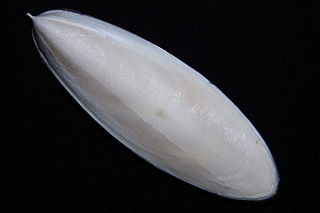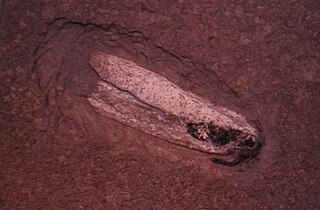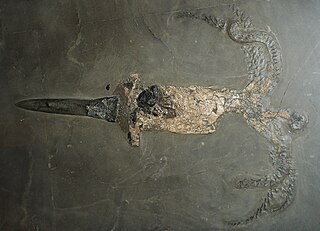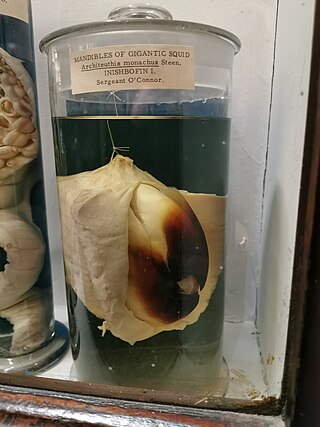
An octopus is a soft-bodied, eight-limbed mollusc of the order Octopoda. The order consists of some 300 species and is grouped within the class Cephalopoda with squids, cuttlefish, and nautiloids. Like other cephalopods, an octopus is bilaterally symmetric with two eyes and a beaked mouth at the center point of the eight limbs. The soft body can radically alter its shape, enabling octopuses to squeeze through small gaps. They trail their eight appendages behind them as they swim. The siphon is used both for respiration and for locomotion, by expelling a jet of water. Octopuses have a complex nervous system and excellent sight, and are among the most intelligent and behaviourally diverse of all invertebrates.

A squid is a mollusc with an elongated soft body, large eyes, eight arms, and two tentacles in the orders Myopsida, Oegopsida, and Bathyteuthida. Though many other molluscs within the broader Neocoleoidea are also called squid despite not strictly fitting these criteria. Like all other cephalopods, squid have a distinct head, bilateral symmetry, and a mantle. They are mainly soft-bodied, like octopuses, but have a small internal skeleton in the form of a rod-like gladius or pen, made of chitin.

A cephalopod is any member of the molluscan class Cephalopoda such as a squid, octopus, cuttlefish, or nautilus. These exclusively marine animals are characterized by bilateral body symmetry, a prominent head, and a set of arms or tentacles modified from the primitive molluscan foot. Fishers sometimes call cephalopods "inkfish", referring to their common ability to squirt ink. The study of cephalopods is a branch of malacology known as teuthology.

Chitin (C8H13O5N)n ( KY-tin) is a long-chain polymer of N-acetylglucosamine, an amide derivative of glucose. Chitin is the second most abundant polysaccharide in nature (behind only cellulose); an estimated 1 billion tons of chitin are produced each year in the biosphere. It is a primary component of cell walls in fungi (especially filamentous and mushroom forming fungi), the exoskeletons of arthropods such as crustaceans and insects, the radulae, cephalopod beaks and gladii of molluscs and in some nematodes and diatoms. It is also synthesised by at least some fish and lissamphibians. Commercially, chitin is extracted from the shells of crabs, shrimps, shellfish and lobsters, which are major by-products of the seafood industry. The structure of chitin is comparable to cellulose, forming crystalline nanofibrils or whiskers. It is functionally comparable to the protein keratin. Chitin has proved useful for several medicinal, industrial and biotechnological purposes.

Coleoidea or Dibranchiata is one of the two subclasses of cephalopods containing all the various taxa popularly thought of as "soft-bodied" or "shell-less". Unlike its extant sister group Nautiloidea, whose members have a rigid outer shell for protection, the coleoids have at most an internal shell called cuttlebone or gladius that is used for buoyancy or as muscle anchorage. Some species, notably incirrate octopuses, have lost their internal shell altogether, while in some it has been replaced by a chitinous support structure. A unique trait of the group is the ability to edit their own RNA.

Cuttlebone, also known as cuttlefish bone, is a hard, brittle internal structure found in all members of the family Sepiidae, commonly known as cuttlefish, within the cephalopods. In other cephalopod families it is called a gladius.

Octopodiformes is a superorder of the subclass Coleoidea, comprising the octopuses and the vampire squid. All living members of Octopodiformes have eight arms, either lacking the two tentacles of squid or modifying the tentacles into thin filaments. Octopodiformes is often considered the crown group of octopuses and vampire squids, including all descendants of their common ancestor. Some authors use the term Vampyropoda for the same general category, though others use "Vampyropoda" to refer to the total group. Another term is Octobranchia, referring to cephalopods without prominent tentacles.

Promachoteuthis sloani is a species of squid from the northern Atlantic Ocean. It is known from only three specimens and very little is understood of its biology. P. sloani is characterised by several morphological features: nuchal fusion is absent between the head and mantle, the arms generally bear 3–4 series of suckers, and papillae are present on the tentacles.

Nidamental glands are internal organs found in some elasmobranchs and certain molluscs, including cephalopods and gastropods.
Boletzkyida is a primitive order of teuthid coleoid cephalopod: the boletzkyids are thought to be the earliest forms of coleoid cephalopods, and appear to form a link between nautiloid orthocerids and more advanced coleoids. Boletzkyida was named and described by Bandel, Reitner, and Sturmer in 1983 (B.R.&S) from specimens found in the Lower Devonian black slate in Germany.

The molluscshell is typically a calcareous exoskeleton which encloses, supports and protects the soft parts of an animal in the phylum Mollusca, which includes snails, clams, tusk shells, and several other classes. Not all shelled molluscs live in the sea; many live on the land and in freshwater.

Mollusca is the second-largest phylum of invertebrate animals, after Arthropoda; members are known as molluscs or mollusks. Around 76,000 extant species of molluscs are recognized. The number of fossil species is estimated between 60,000 and 100,000 additional species. The proportion of undescribed species is very high. Many taxa remain poorly studied.

Cuttlefish, or cuttles, are marine molluscs of the order Sepiida. They belong to the class Cephalopoda which also includes squid, octopuses, and nautiluses. Cuttlefish have a unique internal shell, the cuttlebone, which is used for control of buoyancy.

Teudopsis is a genus of the coleoid cephalopod family Teudopsidae, known only from Lower Jurassic gladii. It has been reported from Alberta, Canada and Europe. The life appearance of Teudopsis is probably best inferred by its close relative Trachyteuthis. A fossil with soft tissue preservation shows that this animal may have had two mantle fins, which may also be the case for Teudopsis.
The cephalopods have a long geological history, with the first nautiloids found in late Cambrian strata, and purported stem-group representatives present in the earliest Cambrian lagerstätten.

Belemnitida is an extinct order of squid-like cephalopods that existed from the Late Triassic to Late Cretaceous. Unlike squid, belemnites had an internal skeleton that made up the cone. The parts are, from the arms-most to the tip: the tongue-shaped pro-ostracum, the conical phragmocone, and the pointy guard. The calcitic guard is the most common belemnite remain. Belemnites, in life, are thought to have had 10 hooked arms and a pair of fins on the guard. The chitinous hooks were usually no bigger than 5 mm (0.20 in), though a belemnite could have had between 100 and 800 hooks in total, using them to stab and hold onto prey.

All extant cephalopods have a two-part beak, or rostrum, situated in the buccal mass and surrounded by the muscular head appendages. The dorsal (upper) mandible fits into the ventral (lower) mandible and together they function in a scissor-like fashion. The beak may also be referred to as the mandibles or jaws. These beaks are different from bird beaks because it crushes bone while most birds don't.

Cephalopod fins, sometimes known as wings, are paired flap-like locomotory appendages. They are found in ten-limbed cephalopods as well as in the eight-limbed cirrate octopuses and vampire squid. Many extinct cephalopod groups also possessed fins. Nautiluses and the more familiar incirrate octopuses lack swimming fins. An extreme development of the cephalopod fin is seen in the bigfin squid of the family Magnapinnidae.
Eromangateuthis is an extinct genus of large plesioteuthidid cephalopod from the Cretaceous of Australia and possibly Canada.
Antarcticeras is an extinct genus of enigmatic cephalopod from the Eocene of Antarctica. It contains a single species, A.nordenskjoeldi. It is either considered the last of the "orthocone"-type cephalopods, the only member of its subclass Paracoleoidea & a descendant of the orthoceratids, and a remarkable example of convergent evolution with coleoid cephalopods, or an oegospid squid and a transitional form in the development of the modern squid gladius, of which it is the only preserved example.





































